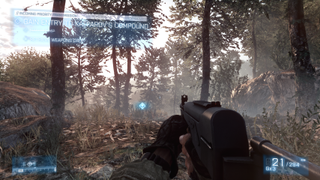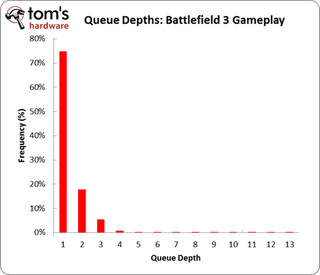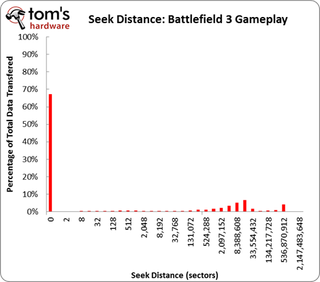Exploring SSD Performance In Battlefield 3, F1 2011, And Rift
Gameplay In Battlefield 3

The 18-minute captured trace from Battlefield 3 represents playing through the Kaffarov mission from the moment Dima hits the ground to when he jumps onto the helicopter.
| Overall Statistics | Battlefield 3: Gameplay |
|---|---|
| Elapsed Time | 18:13 |
| Read Operations | 8 206 |
| Write Operations | 1 708 |
| Data Read | 487.32 MB |
| Data Written | 25.95 MB |
| Disk Busy Time | 2.22 s |
| Average Data Rate | 231.32 MB/s |
When you fire up Battlefield 3 and load a mission, you're almost exclusively reading data from your drive. That matches our experience with Crysis 2. However, there's an interesting difference during gameplay. Whereas Crysis 2 registers a lot of write activity (which Crytek tells us can happen the first time through the game as shaders are compiled), Battlefield 3 is mostly reading data from the drive.
The result in Battlefield makes more sense than Crysis. As you're playing a game, there shouldn't be much reason to write to disk aside from saving the game state. However, progressing through a level necessitates loading textures, meshes, and so on.
Just as interestingly, most operations occur at a queue depth of one. Everyone's play style differs, but we shot our way through this mission quickly. In Crysis 2, fast action meant the game had to address more commands concurrently, resulting in higher queue depths. Battlefield 3 is different, as its storage operations don't stack up.
I/O Trends:
- 26% of all operations are 4 KB in transfer size
- 37% of all operations are 128 KB in transfer size
- 67% of all operations are sequential
- 75% of all operations occur at a queue depth of one
- 23% of all operations occur between a queue depth of two and three



Stay on the Cutting Edge
Join the experts who read Tom's Hardware for the inside track on enthusiast PC tech news — and have for over 25 years. We'll send breaking news and in-depth reviews of CPUs, GPUs, AI, maker hardware and more straight to your inbox.
Current page: Gameplay In Battlefield 3
Prev Page Loading Levels In Battlefield 3 Next Page Launching F1 2011Most Popular

